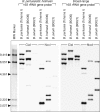Characterization of a highly conserved island in the otherwise divergent Bordetella holmesii and Bordetella pertussis genomes
- PMID: 17041054
- PMCID: PMC1698220
- DOI: 10.1128/JB.01081-06
Characterization of a highly conserved island in the otherwise divergent Bordetella holmesii and Bordetella pertussis genomes
Abstract
The recently discovered pathogen Bordetella holmesii has been isolated from the airways and blood of diseased humans. Genetic events contributing to the emergence of B. holmesii are not understood, and its phylogenetic position among the bordetellae remains unclear. To address these questions, B. holmesii strains were analyzed by comparative genomic hybridization (CGH) to a Bordetella pertussis microarray and by multilocus sequence typing. Both methods indicated substantial sequence divergence between B. pertussis and B. holmesii. However, CGH identified a putative pathogenicity island of 66 kb that is highly conserved between these species and contains several IS481 elements that may have been laterally transferred from B. pertussis to B. holmesii. This island contains, among other genes, a functional, iron-regulated locus encoding the biosynthesis, export, and uptake of the siderophore alcaligin. The acquisition of this genomic island by B. holmesii may have significantly contributed to its emergence as a human pathogen. Horizontal gene transfer between B. pertussis and B. holmesii may also explain the unusually high sequence identity of their 16S rRNA genes.
Figures





References
-
- Beaumont, F. C., H. Y. Kang, T. J. Brickman, and S. K. Armstrong. 1998. Identification and characterization of alcR, a gene encoding an AraC-like regulator of alcaligin siderophore biosynthesis and transport in Bordetella pertussis and Bordetella bronchiseptica. J. Bacteriol. 180:862-870. - PMC - PubMed
-
- Boursaux-Eude, C., S. Thiberge, G. Carletti, and N. Guiso. 1999. Intranasal murine model of Bordetella pertussis infection: II. Sequence variation and protection induced by a tricomponent acellular vaccine. Vaccine 17:2651-2660. - PubMed
-
- Braun, V., S. Mahren, and M. Ogierman. 2003. Regulation of the FecI-type ECF sigma factor by transmembrane signalling. Curr. Opin. Microbiol. 6:173-180. - PubMed
Publication types
MeSH terms
Substances
Associated data
- Actions
- Actions
- Actions
- Actions
- Actions
- Actions
- Actions
- Actions
- Actions
- Actions
- Actions
- Actions
- Actions
- Actions
- Actions
- Actions
- Actions
- Actions
- Actions
- Actions
- Actions
- Actions
- Actions
- Actions
- Actions
- Actions
- Actions
- Actions
- Actions
- Actions
- Actions
- Actions
- Actions
- Actions
- Actions
- Actions
- Actions
Grants and funding
LinkOut - more resources
Full Text Sources
Molecular Biology Databases

